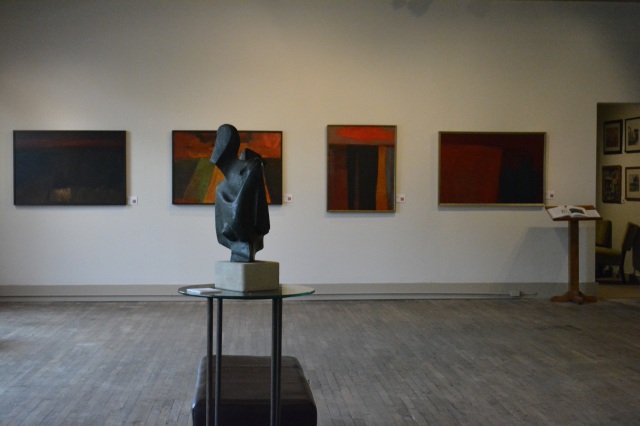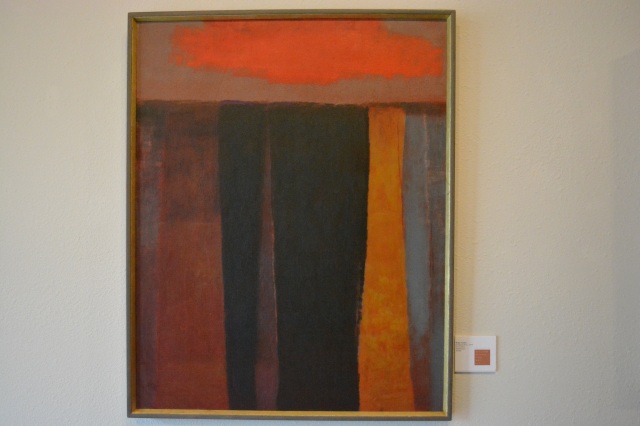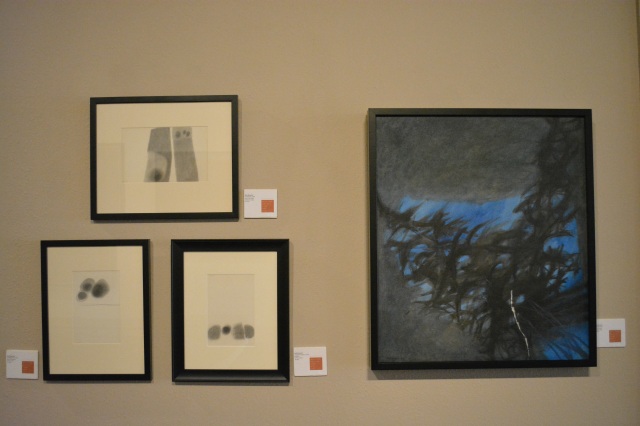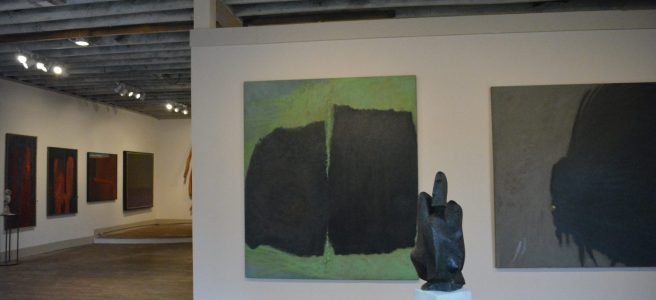It has been too long-American art institutes need to look into mid-century modernism outside of the New York school. Suddenly, there is a flourishing interest in the state of Texas, particularly in Houston. Macrocosm/Microcosm: Abstract Expressionism in the American Southwest just concluded at the Fred Jones Jr. Museum of Art. Bayou City Chic: Progressive Streams of Modern Art in Houston is on view now at the Art Museum of South Texas. Behind the scenes, the William Reaves Gallery plays a central role in raising the status of a group of modernist artists in Texas and bridging the gap between collectors and scholars.
The current exhibition at William Reaves Gallery – Reductive Landscape by McKie Trotter and Jack Boynton – brings together two artists who were connected through their Fort Worth years. Trotter, who taught Boynton at Texas Christian University, stayed in Cowtown; while Boynton, upon receiving his MFA in 1955, joined a group of young artists in Houston, where abstract expressionism was fermenting.

Trotter, born in Manchester, Georgia, came to Fort Worth in 1948. His work from the 1940s (not included in the current exhibition) shows a drastic transition from regionalism to European modernism with traces of cubism and surrealism, perhaps through his interactions with the Fort Worth Circle.
But Trotter did not stop there. He was not firmly associated with the group, and the paintings in the current exhibition explain why. It was in the 1950s that Trotter began his long engagement in the “arrangement of tectonic masses.” It was hard to know to what degree Trotter digested the rapidly changing dynamics of the art world on the East Coast of that time, but his art is unequivocal about his response to the environs of the American Southwest. If spirits of mid-century modernism were, in fact, un-bounding and universal, then nature, from which imageries were referenced, branded Trotter’s art with regional specifics.
Boynton was discovered early on. He was already included in the “Younger American Painters” show at the Guggenheim before he graduated from TCU. In the late 1950s and early 1960s, the Dallas art scene seemed to be in denial of the young talent’s permanent move to Houston such that Dallas Morning News still referred to Boynton as a Fort Worth artist when covering his exhibition at galleries or annual juried shows at Dallas Museum of Fine Arts.
Many of Boynton’s paintings in the exhibition are from the late 1950s and 1960s. Ironically, it was a period of uncertainty for him. That early success did land him a job at the University of Houston, for just two years. Venturing into California (San Francisco Art Institute) and New Mexico (University of New Mexico) did not enable him to secure a teaching position in the early 1960s. He eventually joined the newly formed art department at the University of St. Thomas in 1969.
The two artists, however, show distinctly different temperaments and aesthetics.

Trotter’s abstraction of forms is more outward and direct, yet constructed in tightly controlled designs. His synthetic planes often laid out orderly in parallel strips or stacked blocks, speak of the immense land of the Southwest viewed from afar. His colors, albeit surreal, are reminiscent of the sharp contrast of Texas light — between the overexposed brightness and dark shadows lay a manifold of saturated colors from the land alone, leading to both optical and psychological effects. It is particularly interesting to see where the edges of forms collide. They are not only indicative of shifting terrains or vegetation but also suggestive of spatial relationships.
Trotter adopts Earthscape (or Texascape, occasionally) for many of his paintings. In each, he perpetuates an ephemeral impression into solid masses. Had nature provided more precise geometry and a softer light that necessitated pentimenti treatment, Trotter would have come to define his Ocean Park series a decade earlier.
Comparatively, Boynton’s paintings look introverted. Nor would the titles such as Dissection or Reflections dispel the vagueness of his reference. If Trotter finds his way to paint landscapes both mesmerizing and soothing, Boynton seeks the opposite and captures the moment of becoming. Often, there is impenetrable darkness hovering in the air. Here, the infinite scale does not need a horizon line. Instead, the immense space is indicated by directly placing dark against the light as if the aerospace has been crushed into a parallel two-dimensional world. The organic forms, be it a circle or fire, retain a suspended tension, ready to spring into a mighty force. That energy makes his large canvases both mystifying and disturbing at the same time.
In particular, Boynton’s propensity for asymmetry and imbalance creates an illusion of transient dynamics. He leaves viewers to speculate on the process and the outcome. In Dissection from 1960, two ominous dark masses clash with bursts of sparkles that extend upward. They look more primordial than Texas. The raw and swirling emotions are matched with vehement brushstrokes.
The infinite scale of his paintings and drawings does not always reside in monumental sizes. A small condensed ball is placed, without a hint of spatial surroundings, under a loosely threaded ball with blurred motion. This 1959 pencil drawing is merely eight by six inches, but all matters of existence, soft or solid, seem to evolve in this cosmic analogy.

The new gallery space, with its ample lighting, an open layout, and vintage flooring, is an ideal venue for work by Trotter and Boynton. Still, I wish the show could expand to a wider period. For Boynton, the darkness of his paintings from the late 1950s and early 1960s may resonate with his personal struggles to become financially stable. It may appear to Boynton, somewhere in the 1960s, that he would not reach the kind of fame that he would have hoped to reap through his early success in the New York art scene. But he persisted. Both Trotter and Boynton painted another half a century after these images were created.
During our visit, we chatted with artist Karen Lastre, who was a friend of Boynton. She recalled their conversation and the lack of opportunities in the 1990s.
“In the end, he has just decided that it is about the work. ‘Stop bickering and stop worrying about it, and just do your work.’ That is a real hard thing to do. Because if you want somebody to see it, you want recognition, but what does that mean if you don’t turn out good work?”
McKie Trotter and Jack Boynton Houston Artists
Discover more from Urban Art & Antiques
Subscribe to get the latest posts sent to your email.



Enjoy your writing, Eric, even if I don’t understand a lot of it. Was fortunate to be introduced to work by both Boynton and Trotter when I was involved with the Weiner Collection of Texas art. Mr. Weiner as usual recognized the quality of work by both these artists and had them in his collection. Several years later through my involvement with CASETA I was able to enjoy some personal time with Jack Boynton on several occasions. Must admit that I didn’t recognize at the time how fortunate I was. As usual I get too soon old and too late smart. Keep up the good work. Morris
LikeLike
Thanks Morris. Would love to hear more. Lin wrote this article, however.
LikeLike
Great writing. Boynton’s reputation will only grow bigger with time as more people outside of Texas see his WHOLE body of © work. His word prints should be compared to Ed Rushca.
LikeLike
Hi
I have a framed Jack Boynton print of a poster. It’s the pointy-toe boot with bluebonnets, spur, etc.
How do I sell it to someone who would appreciate it?
LikeLike
That print is called “Amarillo Boot” and sells unsigned for $35.00. Do you have any other Boynton Prints? Please contact me if you do and want to sell.
LikeLike